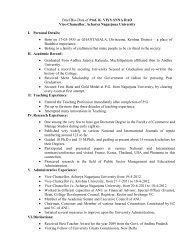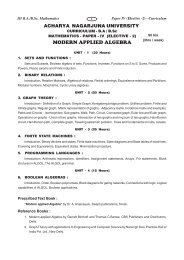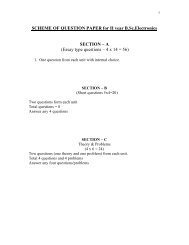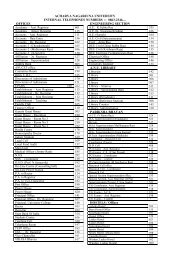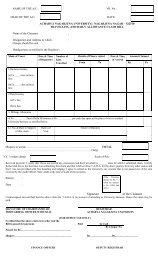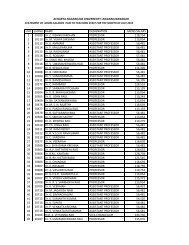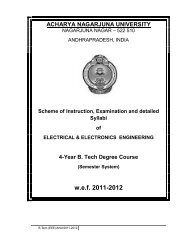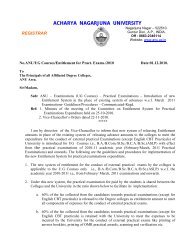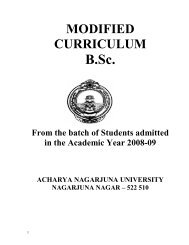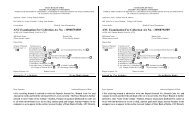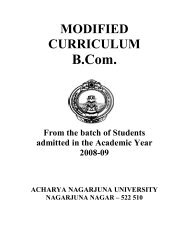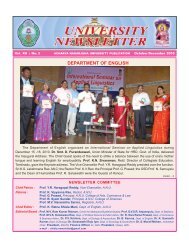B.Sc. - Acharya Nagarjuna University
B.Sc. - Acharya Nagarjuna University
B.Sc. - Acharya Nagarjuna University
You also want an ePaper? Increase the reach of your titles
YUMPU automatically turns print PDFs into web optimized ePapers that Google loves.
Second Year BIOCHEMISTRY Syllabus<br />
Theory – PaperII: Metabolism and Biochemical Techniques<br />
Unit I : Bioenergetics and Biological Oxidations<br />
120 hrs (4hrs/week)<br />
30 hours<br />
Energy transformations in the living system, Free energy concept. Exergonic and endergonic reactions.<br />
High energy compounds. Phosphate group transfer potential. Substrate level phosphorylation.<br />
Biological oxidations: Definition, enzymes involved oxidases, dehydrogenases and oxygenases. Redox<br />
reactions. Redox couplers. Reduction potential (e, e o , e’ o ). Standard reduction potential (e’ o ) of some<br />
biochemically important half reactions.<br />
Ultra structure of mitochondria. Electron transport chain and carriers involved. Oxidative<br />
phosphorylation, theories of oxidative phosphorylation Mitchell’s chemiosmotic theory.<br />
F o F 1 ATPase. Inhibitors of respiratory chain and oxidative phosphorylation, uncouplers. Formation of<br />
reactive oxygen species and their disposal through enzymatic reactions.<br />
Ultra structure of chloroplast, Cyclic and noncyclic photophosphorylation.<br />
Unit II : Carbohydrate and Lipid Metabolism<br />
30 hours<br />
Concept of anabolism and catabolism. Glycolytic pathway, energy yield. Fate of pyruvate formation of<br />
lactate and ethanol, Pasteur effect. Citric acid cycle, regulation, energy yield, amphipathic role.<br />
Anaplerotic reactions. Glycogenolysis and glycogenesis. Pentose phosphate pathway.<br />
Gluconeogenesis. Photosytnthesis Light and Dark reactions, Calvin cycle, C 4 Pathway.<br />
Catabolism of fatty acids (β oxidation) with even and odd number of carbon atoms, Ketogenesis, de<br />
novo synthesis of fatty acids, elongation of fatty acids in mitochondria and microsomes, Biosynthesis<br />
and degradation of triacylglycerol and lecithin. Biosynthesis of cholesterol.<br />
UnitIII : Metabolism of Nitrogen Compounds<br />
30 hours<br />
General reactions of amino acid metabolism transamination, decarboxylation and deamination, Urea<br />
cycle and regulation, Catabolism of carbon skeleton of amino acids glycogenic and ketogenic amino<br />
acids. Metabolism of glycine, serine, aspartic acid, methionine, phenylalanine and leucine.<br />
Biosynthesis of creatine. Inborn errors of aromatic and branched chain amino acid metabolism.<br />
Biosynthesis and regulation of purine and pyrimidine nucleotides, de novo and salvage pathways.<br />
Catabolism of purines and pyrimidines. Biosynthesis of deoxyribonucleotides ribonucleotide reductase<br />
and thymidylate synthase and their significance. Disorders of nucleotide metabolism Gout, Lesch<br />
Nyhan syndrome.<br />
Biosynthesis and degradation of heme.<br />
UnitIV : Biochemical Techniques<br />
30 hours<br />
Methods of tissue homogenization: (PotterElvejham, mechnical blender, sonicator and enzymatic).



